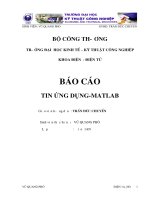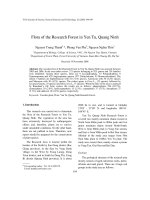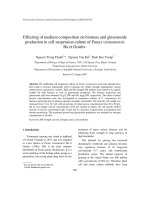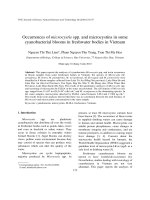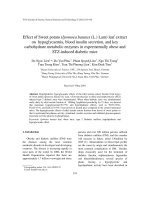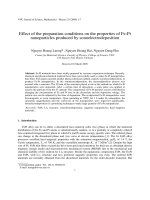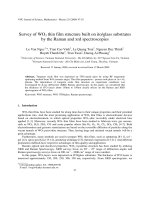Báo cáo " Photoluminescence of ZnO nano-tetrapods " docx
Bạn đang xem bản rút gọn của tài liệu. Xem và tải ngay bản đầy đủ của tài liệu tại đây (1.34 MB, 6 trang )
VNU Journal of Science, Mathematics - Physics 24 (2008) 24-29
24
Photoluminescence of ZnO nano-tetrapods
Nguyen Thi Thuc Hien
*
, Doan Manh Ha, Ngo Xuan Dai, Nguyen Thi Thu Huong
Department of Physics, College of Science, VNU
334 Nguyen Trai, Thanh Xuan, Hanoi, Vietnam
Received 29 November 2007; received in revised form 13 March 2008
Abstract. The ZnO nano-tetrapods have been prepared by the evaporation of metallic Zn powder
at the temperature range of 700
o
C- 950
o
C in air. The influence of experimental conditions, such as
the evaporation temperature and the substrate temperature, on the morphology, the size and the
photoluminescence (PL) was investigated. The XRD pattern showed that the nano–tetrapods were
ZnO with hexagonal structure. The branch size of the tetrapods was about two hundreds
nanometers. The photoluminescence spectrum measured at room temperature consists of two
bands, a narrow band at 380 nm (UV band) and a wide band around 500 nm (green band (GB)).
The intensity of each band, the ratio of the peak intensity of UV band to the GB band and the GB
band position depend on the experiment conditions. However, the peak position of the UV band
was not changed.
1. Introduction
Zinc oxide is one of the most efficient wide band-gap phosphor materials so it is attracting more
attention in the field of optoelectronics and photonic devices. It has a large exciton binding energy (60
meV) which allows UV lasing action to occur even at room temperature [1]. In ZnO, oxygen
vacancies exhibit an efficient green emission. ZnO is also one of gas-sensing materials due to
advantageous features, such as high sensitivity to ambient conditions, low cost and simplicity in
fabrication [2]. Recently, the growth and elucidation of the properties of well-defined nanoscale
materials are critical to efforts directed towards understanding the fundamental physics of
nanostructures, creating nanostructured materials, and developing new nanotechnologies [3]. In this
regard, one-dimentional ZnO, such as nanowires, nanotubes, nanorods have great potential to address
basic issues in applications.
In this report we present the influence of the preparation conditions on the photoluminescence
of ZnO nano-tetrapods prepared by evaporation method.
2. Experimental
ZnO nano-tetrapods have been prepared by simple evaporation method. The evaporation precursor
was Zn powders. The system consists of a horizontal tube furnace and a quartz tube (Fig.1). The Zn powder
was placed at the sealed end of the tube. The first Si substrate was placed 1.0 cm far from the Zn source.
The place of the Zn source is in the centrum of the furnace. The system was performed in air. The
______
*
Corresponding author. E-mail:
Nguyen Thi Thuc Hien et al. / VNU Journal of Science, Mathematics - Physics 24 (2008) 24-29
25
evaporation temperature (the temperature of the Zn source) was changed from 700
o
C to 950
o
C and hold for
2−60 min. After the evaporation, white fluffy products formed on the Si substrates.
Fig.1. The evaporation system.
The synthesized products were characterized using scanning electron microscopy (SEM, JEOL-
JSM 5410 LV), X-ray diffraction (XRD-D5005). The photoluminescence (PL) and excitation
photoluminescence (PLE) measurements were carried out on the FL3-22 spectrophotometer with a
450 W Xe lamp.
3. Results and discussion
The XRD pattern shown in Fig. 2 indicated that the products deposited on the substrate are ZnO
crystals with hexagonal wurtzite structure and there is no Zn peak.
10 20 30 40 50 60
0
100
200
300
400
500
intensity
2-theta (degs)
Fig. 2. XRD pattern of ZnO nanotetrapods.
Zn powder
Si substrate
Quartz tube Furnace
Air
(100))
Intensity (a.u.)
(002)
(101)
(102)
(110)
Nguyen Thi Thuc Hien et al. / VNU Journal of Science, Mathematics - Physics 24 (2008) 24-29
26
The morphology of as-prepared products was characterized by SEM. The results showed that
the morphology of all products was tetrapods and depends on the evaporation temperature, the
substrate temperature (exactly, the substrate temperature zone) and the evaporation time. In this study
the evaporation time was 60 min. Fig. 3 shows the SEM images of the tetrapods when the evaporation
temperatures were 700
o
C and 800
o
C. It is seen from Fig. 3 (a) that at 700
o
C, the tetrapods started to
form but the lengths were short. At 800
o
C the lengths were longer (Fig.3 (b)).
a) b)
Fig. 3. SEM images of ZnO nano-tetrapods evaporated at (a) 700
o
C and (b) 800
o
C.
When the evaporation temperature was 900
o
C, the products have two types depending on the
substrate temperature. We denote the products with higher substrate temperature (next to the Zn source
and far from the open end of the tube (Fig.1) by sample A and the products with lower substrate
temperature zone (far from the Zn source, next to the open end) by sample B. The results showed that A
has bigger size with a tip shape and B has a rod shape with a smaller size (about 200 nm).
a) b)
Fig. 4. SEM images of ZnO nano-tetrapods evaporated at 950
o
C: (a) sample A, (b) sample B.
Nguyen Thi Thuc Hien et al. / VNU Journal of Science, Mathematics - Physics 24 (2008) 24-29
27
This behavior was also for the evaporation temperature of 950
o
C. In Fig. 4 are SEM images of
the sample evaporated at 950
o
C. From the SEM images it is expected that our synthesis was based on
the thermal evaporation of Zn powders without the presence of catalyst, therefore the ZnO tetrapods
were formed by oxidation of evaporated zinc vapor in gas phase. This growth was governed by a
vapor-solid (VS) process [4]
For investigation of the optical properties of ZnO nano-tetrapods, the PL and PLE spectra were
measured at room temperature. Fig. 5 shows the PL spectra for ZnO nano-tetrapods evaporated at
900
o
C. The excitation wavelength is 335 nm. It is seen that the PL spectra consist of a strong, narrow
peak in a near UV region (380nm) (UV band) and a broad peak of 495 nm in the visible region (green
band (GB)). The UV emission peak is due to the exciton recombination and the broad peak at 495 nm
is attributed to defect levels in the band- gap, e.g. the radiative recombination of a photogenerated hole
with an electron trapped by the oxygen vacancy [5].
Fig. 5. PL spectra of ZnO nano-tetrapods evaporated at 900
o
C, under 335 nm
excitation. The substrate temperature zone is about (a) 800
o
C, (b) 700
o
C, (c) 600
o
C.
It is seen from Fig. 5 that, the lower substrate temperature is, the lower PL intensities for both
bands are, but the ratio of the peak intensities of UV band to that of the green band (UV/GB)
increases, e.g. 1/1, 2/1 and 3/1 for a, b and c, respectively. Besides, the peak positions of the two
bands were unchanged when the substrate temperature was changed. The decrease of PL peak
intensities with the substrate temperature in Fig. 5 is probably concerned with the crystallization of
ZnO tetrapods. When the substrate temperature increases, the higher crystallization of nano-tetrapods
occurs and this leads to the increase of the PL intensity. The increase of the ratio UV/GB is due to the
increase of the oxygen concentration of the substrates closer to the open end of the quartz tube, e.g. the
decrease of oxygen vacancies results in the decrease of the GB intensity.
Wavelength (nm)
Intensity (a.u)
Nguyen Thi Thuc Hien et al. / VNU Journal of Science, Mathematics - Physics 24 (2008) 24-29
28
In Fig. 6 and 7 are PL spectra of ZnO nano-tetrapods deposited at two fixed substrate
temperature (samples A and B) and were evaporated at 700
o
C and 800
o
C. A comparison of PL
spectra in Fig. 5, 6 and 7 illustrates that, beside the similar behavior, such as the ratio UV/GB of the
sample A is smaller than that of B, the difference between them is the red shift of green band when the
substrate temperature decreases (e.g. when the substrate is more far from the Zn source and closer to
the open end of the quartz tube). The change of the ratio UV/GB can be explained like above.
Fig. 6. PL spectra of ZnO nano-tetrapods evaporated at 800
o
C: (a) Sample A, (b) sample B.
Fig.7. PL spectra of ZnO nano-tetrapods evaporated at 700
o
C: (a) Sample A, (b) sample B.
Wavelength (nm)
Intensity (a.u)
Wavelength (nm)
Intensity (a.u)
Nguyen Thi Thuc Hien et al. / VNU Journal of Science, Mathematics - Physics 24 (2008) 24-29
29
The red shift of the green band can be explained as follows: After several reports [5, 6] the
green band (500 nm) is attributed to the oxygen vacancies and the yellow band (about 600 nm) is due
to zinc vacancies. As mentioned above, the samples A are next the Zn source and far from the open
end of the quartz tube so it has a lack of oxygen (rich Zn). It is opposite with sample B, which was
producted at the place far from the Zn source and next the open end of the quartz tube. So these
products have enough of oxygen but lack of zinc.
It is seen from Fig. 5, 6 and 7 that the GB of 576 nm (evaporation temperature is 700
o
C), 550
nm (evaporation temperature is 800
o
C) and 500 nm (evaporation temperature is 900
o
C) were from the
products deposited at the same place in the furnace. This means that the higher evaporation
temperature is, the more blue shift of green band is. It is due to the more Zn vapor can be evaporated
when the evaporation temperature is higher. This leads to most Zn for the products of ZnO tetrapods
evaporated at 900
o
C, when the defect is mainly oxygen vacancies. The GB is the superimposition of
two bands resulting from oxygen vacancies and zinc vacancies.
A comparison of our PL spectrum with other studies showed that the peak positions of 495 nm
and around 570 nm of our study are similar to the PL of ZnO nano-tetrapods nanorods reported by
[7-9].
4. Conclusions
ZnO nano-tetrapods were successfully synthesized by the thermal evaporation of Zn powders
without a catalyst. The morphology of the tetrapods depends on the substrate temperature. The size of
the tetrapods was about 200 nm. The photoluminescence spectrum has two bands, a UV band at 380
nm and a green band around 560 nm depending on the evaporation and the substrate temperature. The
green band is the superimposition of two bands, related with oxygen and zinc vacancies, respectively.
Acknowledgements. Authors of this paper would like to thank to the Center for Materials Science
(CMS), Hanoi University of Science for permission to use PL equipment. Thanks to Hoang Duc Anh
and Nguyen Quang Hoa in CMS for the results of SEM and XRD. This work is supported by Natural
Science Research Program (Project QT-07-16) of Vietnam National University, Hanoi (VNU).
References
[1] Y.K. Park, J. Inhan, M.G. Kwak, H. Yang, S.H. Yu, W.S. Cho, J. Lumin. 78 (1998) 87.
[2] M. Bendahan, R. Boulmani, J.L. Seguin, K. Aguir, Sensor Actuator B 100 (2004) 320.
[3] D. Snoke, Science 273 (1996) 1351.
[4] P. Yang, C.M. Lieber, J. Mater. Res. 12 (1997) 2981.
[5] K. Vanheusden, W.L. Warren, C.H. Seager, D.R. Tallan, J.A. Voigt, B.E. Gnade, J. Appl. Phys. 79 (1996) 7983.
[6] J. Zhong, A.H. Kitai, P. Mascher, J. Electrochem. Soc. 140 (1993) 3644.
[7] Y. Dai, Y. Zhang, Q.K. Li, C.W. Nam, Chem. Phys. Lett. 358 (2002) 83.
[8] A.L. Roy, A.B. Djurisic, W.K. Chan, J. Gao, H.F. Liu, C. Surya, Appl. Phys. Lett. 83 (2003) 141.
[9] Hong Jin Fan, Roland Scholz, Florian M. Kolb, Magrit Zachariar, Appl. Phys. Lett. 85 (2004) 4142.
